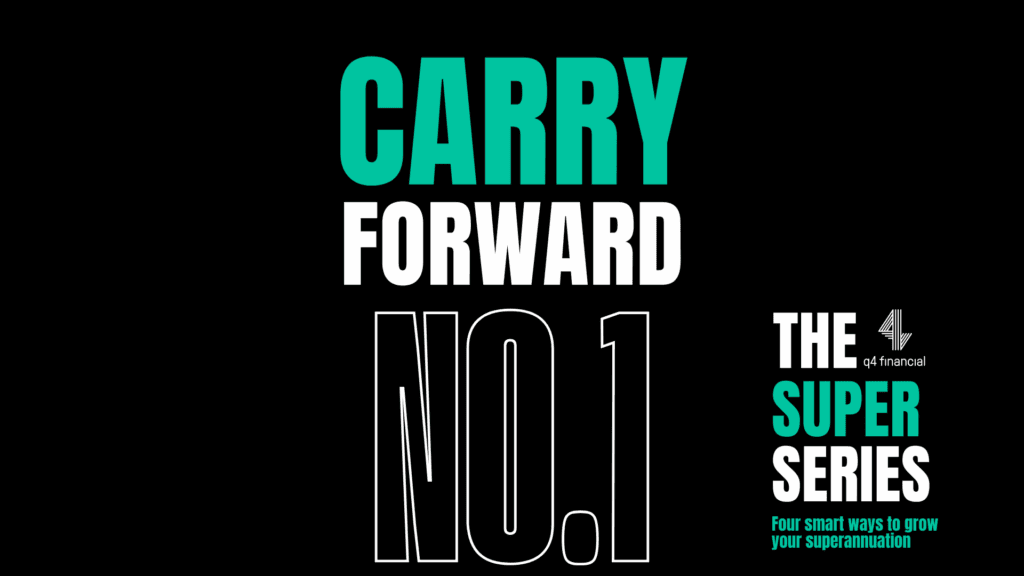
At q4 financial, we’re always looking for ways to help our clients turn small opportunities into long-term financial security. One strategy that’s often overlooked, but highly effective, is the carry-forward concessional contribution rule.
This simple yet powerful rule allows you to make up for unused concessional contributions from previous years — helping you save on tax and accelerate your super balance at the same time.
What is the carry-forward rule?
Since 1 July 2018, if you haven’t used your full concessional contributions cap (the cap for tax-deductible contributions to your super), the unused portion can carry forward for up to five years.
This means you can contribute more than the standard annual cap in a future year when it suits your circumstances — for example, if your income is higher or you have surplus cash flow — and claim a larger tax deduction.
How it works
- The annual concessional contributions cap for FY25 is $30,000.
- If you don’t use the full amount, the unused portion carries forward for up to five years.
- To be eligible, your total super balance must be under $500,000 at 30 June of the previous financial year.
- You can then make additional deductible contributions using your carried-forward amounts.
Example:
If you contributed $10,000 in FY22 (leaving $15,000 unused), you could contribute $45,000 in FY25 (the current $30,000 cap plus $15,000 carried forward). This can deliver a significant tax deduction, especially if your income has increased.
Why use this strategy?
Reduce tax in higher-income years
Carried-forward contributions can be particularly useful if you’ve had a year with higher income, a capital gain, or extra business profits — helping you manage your tax liability more effectively.
Catch up after low-income or career break years
If you’ve had time out of the workforce or lower income in previous years, this rule allows you to contribute more once your cash flow improves.
Plan around key life or business events
This strategy can complement major events such as selling a business, returning to work, or receiving a financial windfall.
Grow your super in a tax-effective environment
Maximising your concessional contributions means more of your wealth grows within super, benefiting from a low-tax structure over time.
What to keep in mind
- Your total super balance must be under $500,000 at 30 June of the prior year.
- Unused cap amounts expire after five years if not used.
- Contributions must be made before the end of the financial year to count.
- You must lodge a valid notice of intent to claim a tax deduction for personal contributions.
More than just a tax benefit
Using carry-forward contributions is not just about tax savings — it’s part of a broader plan to smooth your retirement savings, manage higher income years, and strengthen your overall financial position.
If you’d like to understand how this strategy could work for you, our team at q4 financial is ready to help you make smart decisions for your super and your future.
Want to find out more smart strategies to grow your superannuation? We’ve created our ‘Super Series’
— a four-part blog collection designed to help you understand and use key strategies to grow your super more effectively.
Part 2 – Supercharge Your Super with the Bring-Forward Rule
A strategic way to grow your wealth in a tax-effective environment
Part 3: Super Splitting: A Smart Wealth Strategy for Couples
A simple way to balance super and plan for a stronger financial future
Part 4: The Spouse Offset: A smart tax strategy for couples
Build wealth together and reduce tax along the way
The information provided in this blog is for general informational purposes only and does not constitute professional advice. While we strive to ensure the accuracy and completeness of the content, we make no guarantees regarding its reliability or applicability to your specific circumstances.
Key Points:
- Not Professional Advice: This blog is not intended to replace professional tax advice. Consult a qualified tax advisor for personalised guidance.
- No Liability: We are not responsible for any errors or omissions, nor for any actions taken based on the information provided.
- Subject to Change: Tax laws and regulations are subject to change. Ensure you are up-to-date with the latest information.
- Personal Circumstances: Individual tax situations vary. The strategies discussed may not be suitable for everyone.
- External Links: Any external links provided are for convenience and do not imply endorsement. We are not responsible for the content of external sites.
